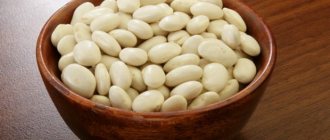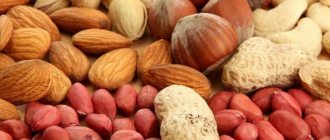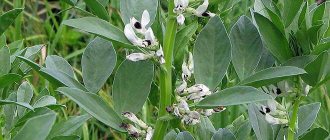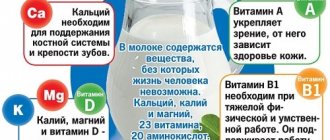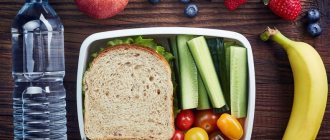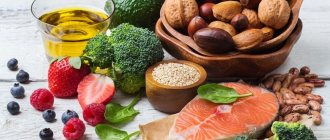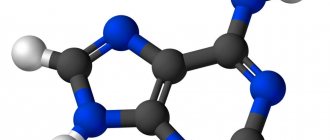Proper nutrition often focuses on animal proteins from eggs, poultry, fish and meat. Plant proteins, the sources of which include beans, are somehow forgotten. This is not good for the body, because the variety of nutrients in the diet is reduced. Legumes are also needed for weight loss, as they give a feeling of fullness due to the fiber and protein they contain.
Benefits and contraindications
- legumes contain many nutrients - protein, iron, fiber, zinc, folic acid, potassium, calcium, phosphorus, magnesium, B vitamins;
- studies show that 1/2 cup of legumes will provide 24% of the daily folate, 15% of protein and 20% of fiber; legumes are high in lysine, an essential amino acid that the body cannot produce alone;
- antioxidants in legumes, namely polyphenols, accelerate the elimination of toxins and help the body fight even serious diseases - cancer is also one of them;
- legumes consist of 80% complex carbohydrates - and they help avoid “spikes” in blood sugar levels, and at the same time type 2 diabetes;
- Legumes contain little saturated fat - the risk of increasing cholesterol in this case is minimal. Some legumes (soybeans, lentils, beans and chickpeas) also contain saponins and phytosterols - they reduce the level of “bad” cholesterol and the risk of developing cardiovascular diseases by 10%. How? The former combine with cholesterol and remove them from the body, while the latter, on the contrary, compete with it for the same enzymes that help them be absorbed.
In some cases, legume products can be harmful - here are a few contraindications.
Gastrointestinal diseases (gastritis, pancreatitis) - legumes often contain FODMAP carbohydrates - fermentable oligo-, di-, monosaccharides and polyols. The body has difficulty digesting these substances, especially for people with gastrointestinal diseases. Legumes will not harm them only if you completely remove them from the diet or leave a small part - but even in this case there is a risk of causing an exacerbation.
For those who suffer from gout, there is their own diet, and legumes are prohibited in it. The fact is that with this disease, metabolism is disrupted, and uric acid (slag) in legumes greatly complicates this process and affects the joints.
In case of allergies to peanuts and soybeans, legumes should also be avoided - the reaction is caused by allergens in their composition (profilin, glycinin, vicilin).
Cooking recipes
Among the most popular cooking methods are: steaming, casseroles, soups, vegetable salads, stewing in oil, stews and others.
In addition, flour is prepared from legumes, which is added when baking baked goods to increase their benefits and nutritional value.
Beans for weight loss
Beans are a nutritious, low-calorie food that is ideal for weight loss.
Beans contain a minimum of vegetable fat and carbohydrates, but a lot of fiber, which has a beneficial effect on the body of a person losing weight.
Vegetarian salsa
Adding different types of legume products from the list to your food will allow you to quickly satisfy your hunger, a feeling of comfort and satiety for a long time, which significantly reduces the amount of food consumed.
Beans speed up metabolism, which allows you to digest food and break down fats faster.
List of legume products:
- beans;
- peas;
- chickpeas;
- lentils;
- peanut;
- soy;
- lupine;
- tamarind.
Vegetarian salsa
A popular dietary and vegetarian dish with beans is vegetarian salsa - a cold Mexican soup made from several types of beans, cilantro, corn, red peppers, onions and tomatoes with spices.
Ingredients:
- corn grains – 1 cup;
- red sweet pepper – 1 pc.;
- canned beans – 100 g;
- green peas – 80 g;
- onion – 1 pc.;
- green onion – 2 pods;
- green pepper – 1 pc.;
- tomato – 4 pcs.;
- tomato juice – half a glass;
- cilantro – 15 g;
- chili powder – 10 g.
The traditional recipe involves the following preparation steps:
- Pour boiled water over the tomatoes, peel them and chop them.
- Chop a few green onions and cilantro.
- Place the pan on the fire, add olive oil and all ingredients.
- Fry vegetables in oil, sprinkle hot pepper powder on top, add water and cook for 5-10 minutes.
- Remove the pan from the heat, add beans, green peas, and add tomato juice.
- Transfer contents to a tureen and serve cold.
Refried beans
Fried beans
Fried beans are considered a delicious dish and a dietary food category. You can prepare this dish using various legume products from the list, but beans are the best.
The following ingredients will be required:
- dried beans – 150 g;
- soda – 1 tsp;
- sunflower oil – 2 tbsp. l.;
- sea salt – 1 tsp.
Preparation includes the following steps:
- The beans must be soaked in cold water for 16 hours, add 1 tsp. soda
- Remove the beans from the water, dry them, and cut them on the sides.
- Heat a frying pan with vegetable oil, add the fruits, fry until golden brown.
- Sprinkle with sea salt and place on a plate.
- Serve with fresh herbs.
Be sure to read: Calorie content of pea puree per 100 grams: what determines how many calories are in peas with butter
Lentil sweets
In addition to traditional dietary dishes, you can also prepare unusual treats – sweets – from beans.
To prepare low-calorie and healthy sweets, any type from the list of legume products is used, but most often lentils, nuts and dried fruits are used as the basis.
For cooking you will need:
- red lentils – 140 g;
- dates – 10 pcs.;
- dried apricots – 80 g;
- raisins – 50 g;
- chopped walnuts – 110 g;
- cocoa powder – 4 tbsp. l.;
- sugar powder – 40 g.
Lentil candies
Recipe for making delicious dietary lentil candies:
- Boil a glass of red lentils and let cool.
- Take 100 g of dried apricots, 10 dates, 50 g of raisins and walnuts, add everything to a blender and grind.
- Add lentils to the blender and grind again.
- Add 1 tbsp to the resulting mixture. l. cocoa and powdered sugar and mix.
- Place in the refrigerator for a couple of hours.
- Form balls of equal size and roll in powdered sugar.
What are legumes best suited for - weight loss, muscle gain, healthy nutrition?
In general, a large amount of fiber in legumes improves digestion and cleanses the intestines, but here you need to know when to stop – its excess will lead to gas formation, diarrhea and a deficiency of fat-soluble vitamins A, D, E.
But complex carbohydrates in legumes will “save” you from overeating - they work “slowly”, that is, the feeling of fullness lasts longer. Simple carbohydrates, by comparison, immediately increase sugar levels, that is, they give a sharp boost of energy - and, if not used up, it will be deposited in fatty tissues.
How many calories should you eat to lose weight? Calculate in a special calorie calculator
Proteins are made up of amino acids and, unlike carbohydrates, are stored in the muscles. But gaining muscle mass only with the help of legumes, that is, plant proteins, will be difficult - the full composition of amino acids cannot be found in their composition (with the exception of soy). Therefore, it is important to combine legumes with cereals and sources of animal protein (meat, cottage cheese, eggs).
Chickpeas
Beneficial features
Chickpeas, or chickpeas as they are also called, are the unspoken king of vegan cuisine. Rare legume products can compete with it in protein content: almost 30 grams of protein are hidden in 100 grams of chickpeas. This, by the way, is comparable to a chicken egg!
Chickpea hummus
In addition, chickpeas contain a large amount of B vitamins, as well as potassium, magnesium and calcium. All this has a beneficial effect on the functioning of the heart and helps the normal course of redox reactions. The amino acid lysine is involved in building muscle mass without accumulating unnecessary fat. That is why chickpeas can often be found in the diet of athletes and all those who monitor their health.
What to cook
The most popular chickpea dishes are falafel and hummus. It should be remembered that legumes must be pre-soaked for at least 6 hours.
Falafel
In Iranian cuisine, chickpeas are used quite widely, so we don’t use any shortage of recipes. Ash reshte, abgusht (with soy meat), chickpea-bulgur cutlets - this is just a small list of what can be prepared from chickpeas. And from chickpea flour you can make delicious chickpea cakes according to the Indian recipe.
Read more about Iranian cuisine and vegetarian cuisine of Iran.
How to get the most out of legumes - some tips
- Legumes contain antinutrients - substances that interfere with the absorption of certain nutrients - calcium, iron, phosphorus and zinc. These include lectins, phytates, tannins. The “side effects” from them are not the most pleasant - gas formation, bloating - this can be avoided, but then the legumes need to be soaked for 8-12 hours;
- If you don’t have time to cook and soak, you can buy ready-made legume products - fresh or canned. They will only need to be washed;
- It’s better not to go too heavy on legumes – ½ cup is enough to replenish all the necessary valuable substances. Excess fiber in legumes will lead to gastrointestinal problems;
- It is ideal to store legumes in containers, away from sunlight - in a cool and dry place.
Mash
Mung beans, or mung beans, are another popular staple in vegetarian cuisine. Mung bean contains a lot of protein, vegetable fats, slow carbohydrates, B vitamins and fiber. Mung beans are also loved and valued for their large amount of iron.
It is usually not recommended to germinate legume products, but mung bean is a big exception in this case. Mung bean sprouts will restore strength after illness, fill the body with vitamins and give a boost of living energy.
Mung bean goes well with rice - this is how it is prepared in India, Iran, Uzbekistan and many other countries. Of course, everyone adds their own spices, and the taste of the dish is original and unique. Mung bean cooks well and serves as the basis for a nutritious vegetarian soup.
What is the bottom line – are legume products healthy?
Legumes are ideal to add to dishes; they can also be eaten separately, but the main thing here is not to overuse them. On the one hand, legumes prevent the development of diabetes, cardiovascular diseases and cancer. On the other hand, legume products have side effects and contraindications. Among them are problems with the gastrointestinal tract, gout, allergies. But, in general, legumes contain many valuable substances, minerals and vitamins - they cleanse the intestines, remove toxins, keep the immune system in good shape and reduce appetite.
More about training, nutrition, sports medicine and sports as an activity - in the “Health” section
Subscribe to the Sports.ru telegram channel about health
Photo: unsplash.com/v2osk, Miguel Andrade, Edgar Castrejon; globallookpress.com/J. Pfeiffer/https://imagebroker.com/#/search/
What plants are legumes?
In addition to traditional beans and peas, the list of legumes includes many more plants with special properties for the human and animal body.
Legume fruits differ in value and energy composition, size, color and method of germination.
Among the most common plants in the list of legume products, it is worth highlighting:
- sweet clover;
- Vika;
- chickpeas;
- feed peas and beans;
- lupine;
- sainfoin;
- Red clover;
- peanut.
This category includes both food and ornamental plants, trees and shrubs, which have been used for many years for feeding livestock, eating and for decorative purposes.
Read also
- What fruits and vegetables to eat in the fall?
- What are isotonics? What types of sports drinks are there? Is it possible to make isotonic water with your own hands?
- Do you need creatine for training? How to take it correctly? Understanding the properties of the additive
- What are the benefits of cherries? Is there any harm? Or is this the perfect berry?
- What berries boost immunity? Which ones are good for the heart and blood vessels?
- What are the benefits of watermelon? Is it possible to eat it every day? How to select and store ripe fruits?
- Walnut: how to use it to get the maximum benefit and not harm yourself?
garden bean
Garden bean consists of 40% protein, and therefore can easily replace meat. Beans are very useful for normal intestinal function, prevention of diseases of the stomach, kidneys, and cardiovascular system. Regular consumption of bean dishes reduces blood sugar and cholesterol, and the manganese included in the composition makes hair thick and shiny.
Garden beans can be added to hearty, rich soups. It goes well with other legumes and adds nutrients to the dish.
Feeding structures
These varieties of this family are good fertilizers. What is the difference between the beneficial properties of different varieties of broad beans?
Vika
This variety helps saturate the soil with hydrocyanic acid and its various salts. Buyers identify only 6 of the best types of this variety for feeding certain crops.
Sainfoin
It grows in a wide variety of conditions. There are 3 types of this variety for feeding various plants. It is known that sainfoin provides the soil with phosphate organic salts and some nitrogenous bases.
Clover
This species plays an important role in soil fertility: it normalizes the nitrogen cycle in the soil.
Alfalfa
It enriches the soil well with phosphate and nitrate compounds. Alfalfa is used as animal feed.
Lupine
A representative of this variety can live in arid climates. As a rule, it is used as green manure for other crops. It is also well suited for feeding various types of fish.
Fenugreek
Like the previous type, it is well suited as a fertilizer and feed for cattle.
Peas
Green peas
Green peas are rich in potassium, phosphorus, magnesium and calcium. In terms of protein content, it can be compared with meat. Peas are very healthy due to their high content of vitamins A, B and C, and a large amount of carbohydrates will give you energy and strength. Green peas also regulate blood clotting, and selenium prevents the proliferation of cancer cells.
You can make a nutritious and healthy puree soup from dried green peas. Salads with the addition of fresh green peas have long become classics of Russian cuisine.
Yellow peas
Yellow peas are familiar to every Russian. Few people know that it is rich in fiber, potassium, calcium, iron, phosphorus, vitamins A, B, C and PP. Yellow peas are incredibly beneficial for kidney disease. It contains thiamine, which has a positive effect on brain function and gives a person additional strength and energy.
What to cook with peas? Everyone ate pea porridge and cream soup as a child. Simple, tasty and healthy dishes. For a change, I recommend making pea gravy for rice.
Peanut
“Beans and suddenly peanuts,” you say. What do they have to do with each other? Indeed, many people mistakenly classify peanuts as nuts, when in fact they are a plant of the legume family.
Almost half of peanuts consists of healthy fatty acids; it contains a lot of easily digestible protein and antioxidants. Peanuts improve memory and attention; they are also useful for the normal functioning of the nervous system, heart, liver and other internal organs. The fruits stimulate blood clotting and enhance platelet formation.
Due to their high nutritional value, peanuts satisfy hunger quickly and for a long time. But be careful - peanuts are an allergen, so you shouldn’t pounce on them or eat them in uncontrolled quantities.
Peanut paste
At home, you can fry peanuts in a frying pan and add them to a hearty and quick breakfast in 5 minutes. Peanuts make an American classic, peanut butter. It's very easy to prepare - all you need is a powerful blender, a little patience and earplugs (just kidding). Spread on bread, add honey and get a tasty, healthy and nutritious snack.
Caution: pulses!
Leguminous vegetables cannot be called a dietary product. Firstly, in addition to proteins, they contain quite a lot of carbohydrates, and secondly, dishes made from them remain in the stomach for about 4 hours or more, thereby provoking the fermentation process in the intestines. These dishes should also be introduced into the menus of children and the elderly with caution.
People suffering from diseases of the blood vessels and heart, gallbladder and pancreas, gastrointestinal tract, as well as colitis should consume pulses with caution. And due to the large amount of purine bases they contain, they are contraindicated in any form for gout, urolithiasis and atherosclerosis.
Author: Ekaterina Solovyova
Please note that the information presented on the site is for informational and educational purposes only and is not intended for self-diagnosis and self-medication. The selection and prescription of medications, treatment methods, as well as monitoring their use can only be carried out by the attending physician. Be sure to consult a specialist.
